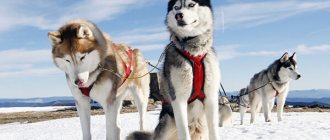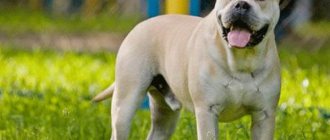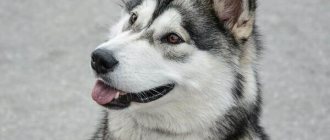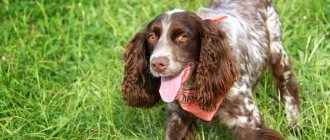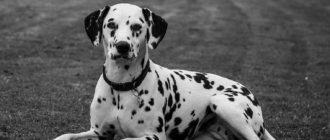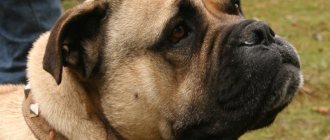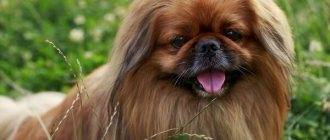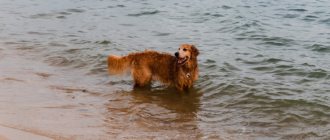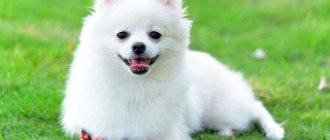Breed traits
Breed traits (on a 5-point scale)
| Labrador Retriever | |||
| Activity | in the house | 3.4 | |
| on the street | 4.4 | ||
| Obedience | training | 4.2 | |
| strangers | 4.2 | ||
| Domination | in family | 1.8 | |
| over dogs | 2.4 | ||
| Defending your territory | from people | 2.2 | |
| from dogs | 2.5 | ||
| Sociability | in family | 4.9 | |
| with strangers | 4.1 | ||
| with dogs | 3.7 | ||
| Concentration | in family | 1.1 | |
| in front of strangers | 1.6 | ||
| with dogs | 1.6 | ||
| Aggressiveness | in family | 1.2 | |
| to strangers | 1.8 | ||
| to the dogs | 2.2 | ||
| to cats | 2.2 | ||
| Family behavior | calmness | 4.6 | |
| demand for affection | 4.6 | ||
| excitability | 3.6 | ||
| playfulness | 4.5 | ||
| excessive barking | 2.6 | ||
| behavioral breakdowns | 2.7 | ||
| Tolerance for children | up to 4 years | 4.4 | |
| over 4 years old | 4.6 | ||
| Institutional use | watchman | 3.7 | |
| bodyguard | 1.9 | ||
This breed is often compared to the following dog breeds: German Shepherd, Rottweiler, Beagle, Doberman Pinscher, Cane Corso.
Upbringing
There are several stages involved in training and raising a puppy. First, the pet must get used to its name and respond when called. Then the puppy needs to be taught the first commands (“Place!”, “Eat!”, “Walk!”).
Next, the animal must be taught to obey simple orders:
- "To me!";
- "Sit!";
- "Lie!";
- "Stand!";
- "Voice!";
- “Give me your paw!”;
- “Aport!”;
- "Fas!";
- "Near!";
- "Ugh!".
Naturally, command training is carried out gradually. You cannot demand everything from a dog at once. On each walk you need to consolidate the commands you have passed and add something new. Each time you should praise your Labrador for correctly carrying out an order. You can also treat your dog to something tasty.
You cannot use force or shout at the animal. The dog may become angry and withdrawn. Then it will not be easy to establish contact with your pet.
Important point! The puppy needs to be taught to stop biting in time. Small Labradors may bite when playing, and this habit must be stopped immediately. When a puppy bites, you should not pull your hand away. You need to scream for your pet to understand that you are in pain.
General characteristics of Labrador
Labrador Retrievers are so called because they belong to the retriever group. They are classified as medium-large breeds, compact in size, but with a powerful build. The height at the withers of an adult male can reach 60 cm, but the weight of Labradors is no more than 35 kg. With proper care they live 12-14 years.
Labrador puppy
This breed is popular all over the world. Not only ordinary dog breeders, but also professional dog handlers consider her the most obedient, devoted, hardworking and smartest. Anyone can have such a pet, since the price of even purebred puppies is low.
The advantages of these dogs
This is one of the few large dogs that are suitable for living in an apartment. They are unpretentious and easily adapt to any conditions. But the Labrador breed also has many other positive qualities:
- they are friendly, not at all aggressive, loyal;
- sociable, but balanced and calm;
- love children, can become an ideal nanny for a baby;
- easy to teach, as they are smart and quick-witted, they understand not only words, but also intonation;
- very playful and active, always ready to play, support the owner in everything;
- flexible, live quietly in the same house with other pets;
- efficient, hardy;
- unpretentious, do not require special care, except for the molting period;
- They are distinguished by a beautiful exterior and artistry, so they always attract attention.
Disadvantages of the breed
But before you get a Labrador Retriever, you need to know about its disadvantages. There are few of them, they are easily corrected by proper upbringing. Many dog breeders call this breed ideal, but Labradors have the following disadvantages:
- clumsy, like to chew on everything, so things in the house may get damaged;
- very active, you need to walk a lot with them;
- loving, good-natured and trusting, joyfully greeting all people, can jump on strangers;
- They have an insatiable appetite, they pick up everything in sight on the street, they love to beg, therefore they are prone to obesity;
- Labradors are not suitable for a small apartment due to their rather large size;
- cunning and intelligent, if trained incorrectly, can manipulate the owner;
- They shed twice a year and very heavily.
Who are they suitable for?
The Labrador Retriever is suitable for keeping in any home. It can be kept both in an apartment and in a private house in the yard. In the latter case, he needs a warm, spacious enclosure. But this pet does not tolerate loneliness, and also does not have protective qualities, so most often Labradors are kept in the house.
Fawn Labrador
This breed is suitable for any people, even those inexperienced in keeping animals. A family with a child should have them, as they love children very much and will never offend them, no matter what they do. These pets easily adapt to the habits and lifestyle of the owner and find a common language with all family members.
But due to its activity and energy, this breed is not suitable for homebodies or people leading a sedentary lifestyle, because they need to be walked a lot. They are worth getting for athletes, hunters, and travelers. The pet will accompany its owner everywhere; this breed is ideal for agility, bike joring, freestyle, and enjoys catching Frisbees and running after a stick.
Labradors are ideal guide dogs. They are easy to train, intelligent and friendly. They become the best companions for the disabled, guides for the visually impaired, and friends for children with socialization problems. This breed is most suitable for canistherapy - a method of treatment and rehabilitation with the help of animals.
Labrador on a walk
Labradors are often used in police service because these dogs have a very sensitive sense of smell. They easily find drugs, explosives, and missing people. But they cannot guard the territory or detain a criminal, since they have absolutely no aggression.
A description of the characteristics of a guide dog, how they are raised and how important they are for blind people can be seen in the video.
Interesting Facts
Labrador dogs are very popular, but most dog owners know them only as loyal companions. Although these animals have an interesting history, and a lot of unusual things can be told about them.
- The breed is called a Labrador Retriever, so they are often identified with Golden Retrievers. But these are two different breeds, differing both in appearance and behavior. Unlike the Labrador, Golden Retrievers have one color option, longer coats, and a graceful build.
- The Labrador is the best swimmer among dogs. Thanks to its webbed feet and specially shaped tail, it easily floats on the water, moves quickly and dives well. And the special waterproof double wool allows you to swim even in cold weather.
- Labrador is classified as a service breed, but not because of its protective qualities. They do not have a sense of their own territory or aggressiveness towards strangers, but they have great efficiency, devotion and obedience.
- Labradors are dogs that are almost insensitive to pain. Thanks to these qualities, they are ideal for rescue work, searching for missing people, and police work. They have a very sensitive sense of smell, which allows them to be used to search for drugs.
- The great thing about the Labrador Retriever is that he can easily control his jaw muscles. This dog will never bite a person, even by accident. They can carry a raw egg in their mouths without damaging it. Therefore, for families with children, the Labrador is an ideal pet. But he loves to chew on everything; he can eat furniture, linoleum, and shoes.
- These pets become mature late, they act like puppies until they are 4 years old. But even as an adult, the Labrador will be playful and mischievous. These are very positive dogs, cheerful and good-natured.
- Previously, Labradors were called St. John's dogs or small Newfoundlands. This is due to the history of the origin of the breed.
Photos of puppies
In appearance, a Golden Labrador puppy is almost the same as an adult, only smaller in weight and height. Already at an early age, a Labrador can see fairly developed muscles, a compact body and a wide cranial part of the head. The head of a four-month-old puppy looks larger relative to its body.
The Labrador breed has certain distinctive features:
- strong long body;
- wide chest;
- powerful neck;
- fairly short loin;
- drooping ears located slightly towards the back of the head;
- almond-shaped eyes;
- elongated muzzle;
- massive round paws with webbed toes;
- tail thick at the base and tapering towards the tip;
- short thick coat of light beige golden color.
History of Labradors
This breed has a short history; it appeared only in the 19th century. Breeding was carried out in the UK, although the birthplace of Labrador retrievers is Canada. These efficient dogs were also called small Newfoundlands, as they were common on this island. There they helped fishermen and hunters. The history of origin is still unclear: either the British brought a ready-made breed to Europe, or they took out its ancestors and started breeding them in Great Britain.
Labrador
The origin of the name is also unclear. According to one version, the Spaniards named the dogs this way, since labrador translates as “hardworking.” According to another version, these dogs originate from the island of Labrador. There is also an option that they were named so because of their black shiny wool, reminiscent of the labradorite stone.
At the end of the 19th century, the British presented the first black Labradors at an exhibition. 1870 is the time of the birth of the breed. A few years later, the first standard was approved, according to which only black dogs were recognized. Two more varieties of Labrador color became standard only at the end of the 20th century. Labradors in fawn, chocolate, and white colors are now popular.
Labrador mouth
In Russia, the breed began to be bred only in the 70s. After one Labrador was brought to Moscow, interest in them arose. But due to the lack of fresh blood, they were first crossed with Newfoundlands. Only since the mid-90s did they begin to meet international standards. Nowadays there are many kennels operating in Russia, the dogs from which take prizes at international exhibitions and live with dog breeders all over the world.
Breed standard
Now there are two types of standards: English and American, in accordance with them, two varieties of the breed are distinguished. Although these dogs began to be imported to America from Europe only in the 20th century. Most breeders use the international standard adopted in 2011.
Labrador with a ball
According to it, the height of an adult male is 56-57 cm, but the height at the withers is acceptable up to 60 cm. The size of the female is slightly smaller. Their height does not reach more than 54-56 cm. Weight is not regulated by the standard. But it is desirable that for adult girls it should be 25-32 kg. The weight of boys can be more - 29-36 kg.
Frame
From the photo you can see that the Labrador has a strong build, compact and harmoniously built. The back is wide, with a straight topline. The loin is short and muscular. The chest is deep and wide.
The body is slightly elongated and has a rectangular format. The withers are well defined, the belly is not sunken and has dewlap. The tail is very thick at the base, tapering towards the end. It is heavy, which helps you move freely through the water.
Head
The head is proportional and large. The muzzle is wide, not sharp. The transition from the forehead to the nose is well defined. The ears are medium, triangular, close to the body. They are set far on the sides of the head and slightly behind.
Head
The eyes are dark, but may be yellow. The nose and lips should be dark. The jaws are strong and powerful. But any photo shows that the dog’s facial expression is good-natured and inquisitive.
Limbs
The limbs are well developed and harmonious. The front are straight, with long shoulder blades and elbow. The hock joints are set low. The paws are compact, rounded, and the toes are arched. Thanks to this structure, the movements are wide, free, light, the front and hind limbs move in parallel.
Wool
The Labrador's coat is short, very thick and smooth. It is tough, but pleasant to the touch. The peculiarity of the undercoat is that it is very thick, dense, and waterproof. This allows the pet to swim in any weather and not freeze in winter, but molting causes problems for the owners.
Color
Colors: black, fawn, chocolate
These dogs have only one color. Sometimes a small white spot on the chest is allowed. Labrador retrievers come in several colors.
- Black Labradorite is the most common option. It was with this color that the breeding of the breed began. The black color should be rich and shiny; a small white spot on the chest is acceptable. Such dogs are non-marking, look impressive, but they don’t look very good in photos.
- Later, brown dogs appeared. All colors from light to dark are allowed. There are chocolate and liver color options. Chocolate Labrador has become more popular in recent years. His eyes can be yellow or brown.
- Fawn-colored Labrador Retrievers are also common. This color was recognized at the beginning of the 20th century. Fawn Labrador can have several types: golden, cream, fawn with chocolate pigmentation. This color looks elegant and attractive.
Varieties
Chocolate Labrador
There are English and American types of Labradors. The American one appeared later; it is distinguished by a more graceful physique, compact size and light bones. The English standard describes a working dog with a large head and muscular limbs. These pets are described as easy to train, obedient and hardworking.
For more information about the characteristics of the English and American type of breed, you can watch the video:
Dimensions, weight and other features
Below is a table of average height and weight for male and female Labradors:
| Age | Weight, kg | Height at withers, cm | Muzzle length, cm |
| 1 month | 3.4-3.8 | 23-23.5 | 3.5-4 |
| 2 months | 7-8 | 30-32.5 | 4.5-5.5 |
| 3 months | 12-14 | 39.5-42 | 6-7 |
| 4 months | 17-19 | 44-46 | 7-8 |
| 5 months | 21-22 | 48-51 | 7.5-8.5 |
| 6 months | 24-26 | 50-55 | 7.5-9 |
| 7 months | 26-28 | 52-56 | 7.5-9 |
| 8 months | 28-30 | 54-57 | 7.5-9 |
| 9 months | 29-32 | 54-58 | 7.5-9.5 |
| 10 months | 30-36 | 54-58 | 7.5-10 |
| Adult | 30-40 | 54-58 | 7.5-10 |
Description of the Labrador's character
The main characteristics of this dog are good nature, playfulness, balance and cheerfulness. They can infect everyone with their optimism. The peculiarity of the pet's character is its loving nature and friendliness towards everyone. Combined with his lack of aggression, this makes him completely unsuitable for the role of a security guard.
Labradors in nature
Another character trait is intolerance to loneliness. The pet's need is to be close to the owner, serve him and obey him. In terms of devotion and fidelity, the Labrador has no equal. But for this reason, he cannot be kept in an enclosure or on a chain, or left alone for a long time.
Genetically, the nature of the Labrador breed includes the need to bring prey to the owner. Without proper upbringing, he can hunt birds, pick up and bring various objects on the street. These dogs love water, so lying in a puddle is considered a fun activity.
Features of training Labradors
Training this dog will not be difficult even for an inexperienced dog breeder. These dogs are so intelligent and obedient that they learn simple commands quickly. They remember and understand several hundred phrases that are often spoken in their presence.
Chocolate color
In addition to the basic course, Labradors can be trained in more complex ways. It is easy to teach them to fetch a stick, a ball, or catch a disc. These pets are suitable for canine sports and love to run with their owner. They are happy to learn; it is best to use praise, affection or treats in training. You should not use punishment or even beat your pet; he understands the strict tone.
Without proper upbringing, a Labrador can become touchy and disobedient. Without communication with a person, he gets bored, gets sick and becomes depressed.
Walking and exercise
For proper development and good health, your puppy needs regular walks and physical activity.
Dogs of this breed love to frolic and run outside. The little Labrador is taught to carry out various commands.
But you need to take into account that the pet gets tired quickly. It is necessary to balance the load with the age of the dog. Typically 20–30 minutes a day are allocated for training. The rest of the time can be devoted to games and entertainment.
For walks, the puppy must have a comfortable leash and collar. Your pet should be trained to wear these outdoor accessories from childhood. The choice of special ammunition for an animal must be approached competently.
Collar for Labrador
To choose a good collar, you need to measure the volume of the dog's neck and add a few centimeters to this value. Puppies grow quickly, so it is better to buy a collar for growth.
For puppies, a product made of nylon is better (such collars are lighter). For an adult Labrador, you can safely buy a leather or canvas collar.
Leash for Labrador
A classic walking leash for a dog is usually made of nylon, nylon or leather. For a puppy, it is better to take a leash of moderate length - this will make it easier to restrain the curious little fidget.
A large adult Labrador requires a strong, wide leash with a durable carabiner. A product made of nylon or tarpaulin would be ideal.
Labrador: maintenance and care
In order for a dog to live a long time and delight all family members with its cheerful disposition, it needs to be provided with proper care. For a loving owner this will not be difficult. But to avoid problems, you need to accustom your Labrador puppy to hygiene procedures as soon as he appears in the house. With proper care, life expectancy will be at least 12 years.
These animals are unpretentious and can be kept in a city apartment. The main condition is to ensure sufficient physical activity. You need to walk with your pet for at least 3-4 hours a day, preferably so that it moves actively. These dogs love water very much, so if possible, you need to take them to a river or lake.
Puppy with kitten
The rules of care are no more complicated than for other pets. After a walk, you need to wipe your paws, trim your nails regularly, and examine your eyes and teeth. You need to be more careful with your ears - they are droopy and often get dirty, which can lead to inflammatory diseases.
A difficulty for some owners is the long-term shedding of their pet. He has a lot of undercoat, and by the time he changes everything, there will be fur all over the house. To avoid this, you need to thoroughly comb your pet every day at this time. The rest of the time, it is enough to comb it once a week.
Thanks to its special properties, the pet's fur cleans itself. Therefore, it does not need frequent washing. Most veterinarians, when asked how long to bathe a pet, answer that 2-3 times a year is enough. The exception is the fawn colored dog. Light fur quickly becomes dirty, and dark spots form around the eyes and ears, as well as on the paws.
Feeding
It is best to feed your pet dry food. If you buy super-premium or holistic options, it will be provided with all the necessary nutrients. Dry food is balanced; usually, this feeding does not require additional vitamin supplements. The main thing is to correctly calculate the amount, since these animals are prone to obesity. It is better to consult a veterinarian, they have a good appetite and can overeat.
Puppy
When feeding natural food, it will be difficult to provide your pet with all the necessary substances. It is important to correctly create a diet, determine how many times he should eat and what portion. Many people are interested in whether it is possible to give a Labrador chicken and vegetables, this is allowed. Sweets are prohibited for him, especially chocolate, pasta, pastries, onions, potatoes, pork, raw fish, chicken bones.
Diseases
Labradors have several diseases that are more common than others. The most common is obesity. These dogs gain excess weight quickly, especially if you don’t watch their diet. To avoid this, you need to consult your veterinarian about how many hours a day your pet needs to run. It is usually recommended to walk for 2-4 hours.
Color black
Atopic dermatitis is common in these dogs. But this disease can also be kept under control by watching your diet. But diseases such as cataracts, osteochondrosis, hip dysplasia in a pet can be congenital.
For more information about what you need to buy for a Labrador puppy and how to provide him with good conditions, you can watch the video:
Vaccination schedule and which ones should be done
To raise a healthy Labrador and avoid frequent visits to the veterinarian, it is necessary to vaccinate the animal against all kinds of diseases on time.
Mandatory vaccinations for a Labrador in the first year of life:
- plague of carnivores (distemper);
- parvovirus enteritis;
- parainfluenza;
- rabies;
- infectious hepatitis;
- leptospirosis;
- trichophytosis;
- microsporia.
The first vaccination against plague is given to an animal at 2 months of age. The vaccination is quite difficult to tolerate: with fever, general weakness and diarrhea. The second vaccination (also against plague) is administered after 3 weeks. This time the Labrador should feel lighter.
At 2.5-3 months, it is necessary to vaccinate the animal comprehensively (one vaccine includes drugs against several diseases at once).
At 4 months of age, the puppy is vaccinated against rabies and the complex vaccine against a group of diseases is repeated. If your baby's teeth change during this period, you should wait. In this case, all vaccinations are given to the Labrador at 5 months.
At 1 year of age, the dog is revaccinated against distemper, rabies and other unpleasant and dangerous diseases with a complex vaccination. These vaccinations must be repeated every year.
How to buy
It is better to purchase a dog from a specialized nursery. Pedigree Labrador puppies cost from 15 to 30 thousand rubles. The cost of show class pets reaches 60 thousand. Before contacting a kennel, you need to study reviews about it, prices, photos of dogs.
Puppies
One of the problems when choosing a novice dog breeder is the gender of the pet. Girls are calmer and more obedient. They only have problems with the opposite sex twice a year during estrus. Boys are more active and efficient, inquisitive, and persistent. But they can mark territory.
If you buy a puppy through an advertisement or on the market, it will be cheaper. The price of a dog without a pedigree is 5-10 thousand. But there is no guarantee that the pet will be purebred, healthy and without character flaws.
Judging by the reviews, the Labrador has more advantages than disadvantages. Many believe that this is the best companion, friend and assistant in everything. It is not for nothing that this breed is used as guide dogs and rescuers. She has a genetically inherent desire to serve people. Their love for children and inability to bite humans make them ideal pets for families with children.
Toilet training a puppy
At 2 months old, a Labrador puppy looks like a very smart, understanding animal. This is the best time to start toilet training your pet - at home and outside.
On the very first day of the puppy’s stay in his new home, it is necessary to determine the place where his tray will be located. When the puppy begins to behave restlessly and sniff, you should take him and show him a place where he can do his business.
If the puppy is not taken care of, he can make a puddle in any corner. Under no circumstances should you shout or hit your pet for this, because he is just learning. Some owners lay out diapers on the floor where the puppy has “marked.”
When the baby begins to urinate on them, the number of diapers is gradually reduced.
Sensing the smell and focusing on it, the pet gets closer to its toilet day by day. If the puppy goes to the litter box on his own, he must be praised and rewarded with a treat.
You can take a smelly diaper for a walk with your puppy. Having chosen a quiet place where there are fewer people and cars, lay out a rag and let the dog sniff. The puppy must understand what is required of him and go to the toilet outside. If this works, you need to praise your smart kid.
Over time, the animal will begin to ask to go outside to relieve itself.

